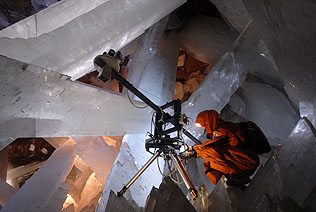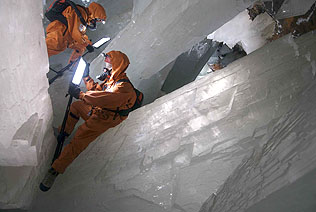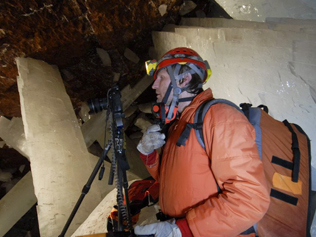Alejandro Macías, a member of the robotics team, |
Rosalio Castillo and Alejandro Macías from the |
CHRONICLE OF A LEARNING EXPERIENCE
October 5. One morning I was asked: how can we film with a video camera inside a cave with an ambient temperature of 50°C and 100% humidity? With this question started a period of two and a half years of work to develop the necessary equipment to film, record and photograph the Crystals’ Cave in Naica, Chihuahua. There was a rumor that a collection of broken-down cameras existed, from attempts to obtain images there. At first, the main concern was to protect the camera, to control and move it at a distance of 100 meters. When you leave the cave there is a passage and after an external door the temperature drops within the range of 33 to 38°C., adequate for installing the “control center” (monitors, infrared receptors, electronics for the motors, etc.) The first step was to develop the necessary equipment to be able to obtain video images and the controls to handle a Panasonic 24P camera, isolating it from the atmosphere and heat by placing it inside a fixed ample heavy wooden box lined with a metal structure, and a thick acrylic at the front to reduce the risk of malfunction. At the same time we began to build our first robot named “Aktun I” (cave in Mayan), capable of moving this 15 kilo box in pan and tilt modes. For this we used a varying- speed, continuous direct current motor, an old film processor used in an aircraft carrier and a car window opener. All this was done in Mexico City without knowing the cave. January 6. Finally at Naica we were able to enter the cave and introduce Aktun II, now made of metal. We connected it two meters from the entrance and… it worked!!! We obtained some images and learned from our errors, for example that the humidity made the bands slip. This would be overcome with a new Aktun built with dented and more precise bands. The next trip was scheduled for April. Again new wooden prototypes were built. Panning stability being of the most importance; the bands and dented pulleys, and both car window openers installed in Aktun III, IV and V did not give the expected results. Aktun VI has now a good leveling system and soft movements. We proceed to build it in metal with a system where the tripod became unnecessary. Electronically we can now manage three video cameras two Panasonic 24P, and one HDV Sony and a Cannon PowerShot Pro camera, controlled via USB at 50 meters distance for fixed images, the maximum distance of control during this trip, until Aktun VIII. At the same time we started to build the led panels, a very efficient illumination system that can work with industrial batteries providing efficient, easy to manage lighting within the cave. April 6. A number of errors, overconfidence and lack of foresight made of this trip a total failure. When installing Aktun VII on the tripod at the door of the cave, a cable was pressed between the tripod and the base causing the electronic controls to short circuit. Once this was fixed when connecting the 50 meter (mother cable) it ended 5 meters away from Aktun so that the control center had to be moved closer to the door of the cave. Our lack of experience within the cave made us decide not to use Aktun during this trip. The leds worked well. This became a personal challenge; I could not allow another error and when thankfully given a second chance we started to work in fail-safe electronic systems, redundant systems, and better connective systems, which means preparing everything for the worst case scenario. June 6. The new equipment was sent to Naica while we stayed in Mexico City. Two weeks earlier we managed to find new motors with a reduction ratio of 1:200, which means that the motor must rotate 200 times for the extreme of the pulley to rotate once. This added to the pulley’s existing reduction of 1:10, gave our control the precision we had been looking for almost a year. Then we introduced a stepper motor. This motor is controlled by computer, and we achieved precision of up to 1/200, or able to take up to 200 photographs in one degree. With this new system we built Aktun VIII, and after multiple tests we discovered that to obtain good results we must take 16 photographs per degree, and in closer objects up to 32 photographs per degree. With this system we started to obtain quality videos. |
Peter Carsten taking photos inside "the crystal cave.” | Two challenges followed: The first challenge was to find software capable of making the whole process automatic. Because the task is so repetitive, it is very difficult to do. We achieved this with visual Basic software which permits to elect the setting of the motors’ movements in such a way that panning, tilting, diagonals, curves, etc. can be programmed, as well as the number of photos to be taken in each session. For this purpose we purchased a Nikon D200 with software able to control all these functions, except for focus and zoom. The second challenge was more complicated. We had to introduce in the crystals’ cave a computer and electronic controllers. The solution we thought of, was to introduce all these components inside an icebox thus controlling humidity, but the temperature reached 95°C in less than 20 minutes at an ambient temperature of 25°C. We lowered the temperature by connecting a compressed-air hose to cool the contents. |
November 6. First problem; the temperature of the “cocoon” (the computer near the cameras) does not drop; we have to get more compressors to see if we manage to lower the temperature. In the end we required three of them working simultaneously to be able to maintain the CPU’s between 70 and 75°C. In fact, we could detect in the temperature monitor any leak or malfunction of a compressor because the temperature would start rising. The “Molex” connector used to make the connections from the cameras to the cocoon, resulted to be very weak for the daily work in the crystals’ cave. The USB connector to the Nixon D200 camera would oxidize very rapidly and most mornings the connection to the camera failed. During the second day of work inside the cave, someone leaned on Aktun VIII rendering the panning mode inoperable. This being overcome the work immediately continued. During three working weeks we obtained 21 minutes of video, taking more than 5,000 photographs of 10.2 megapixels each. An important development was the use of “splashbags”; plastic bags adhered to optical glasses of great quality closed with a plastic belt, which allowed us to do away with the hindrance of the fixed box. Above Aktun VIII we had a Nikon D200 camera. A Sony HDV and we also monitored a 35mm Arri movie camera. During this trip we tested our cold suits and respirators for the first time; they allowed us to remain in the cave for up to one hour, the span of time we needed to change Aktun to a different position, we also tested the cold vests which made possible for us to remain in the cave for 30 min. We also tested other configurations for the cocoon until it was no longer necessary to keep it cool with external air, working at a temperature of 65°C. This was achieved using a 190 litre box with very thin plastic walls thus achieving a natural transfer of heat between the cave and the cocoon. With this cocoon we made “Aktuncito” (little Aktun) work; a system that only works in a panning mode with which we made some interesting takes of Aktun VIII working. The leds are an important part of the illumination system, but since their span is so ample, we also aided their movements with “kinoflows”. We returned to Mexico City with a lot more knowledge as to how the work had to be done inside the crystal’s cave, such as recognizing that the assemble speed and trustworthiness of the connections are essential. So we designed a new system to assemble with magnets, which plays an important role; we substituted the connections Canon to Molex, gave USB cable ends a gold bath, used stainless steel screws and the least number of connections possible: the cocoon now in its new box and safety features in each of the motors are some of the physical features, as well as new important improvements in the software constitute the work done in the first months in 2007. During a team session, a new idea was put forth: mount an arm in Actun VIII enabling it to take the camera from its axis to achieve better movements. The improvement is important and shows that it can continue to move with the same precision, except that after the motors are moved, a short waiting period is required to stabilize the system. We had another idea: why not place a motor arrangement on the tip of the arm, which would allow movement with the same precision? This is how axis Z was born adding a new dimension to the movements. The software was improved and we prepared for the next trip. May 7. There are many activities inside the cave so we had to wait; meanwhile in a nearby tunnel we tested the latest improvements to Aktun VIII: A system of stepper motors with bands to enable us to take control of focus and zoom of the Nikon D200 camera. We look after the software’s latest arrangements and corrections; finally we are able to enter the cave for two full days. We make two long movements and many short ones aided by robotic lights, which we think would make the illumination easier; unfortunately they only stay lit for 15 min and then turn off, self protection due to the excessive heat, and as a result our progress is slower. Good news, the equipment lights up every day without incident and the connections work very well. July and September. Two trips where the agenda does not permit robotics work. But we are able to test the modifications and robotic lights with success. December 07. We are perfectly prepared and trained, nevertheless faults in the mine’s electrical current cause our robotic lights to turn off and reset and they end up flickering all the time, the electric current changes from 100 to 150 v most of the time; There are attempts to establish a balance from the transformer without results; we lose a computer in the control center, a monitor, a web controller, the robotic lights do not obey and the worst part, the movements obtained have an important flicker, the mother cable looses the connection to the web (which allows connection to the cocoon). Step by step each problem is solved and we are able to work. The most important decision made is to sleep in the subterranean camp since the electrical problems would reset the equipment during the night, which resulted in the loss of a day’s work. A solution to the flicker has been to illuminate exclusively with leds. Finally we completed this stage of the work and ended up with more than 21,000 photographs, another 8 minutes of great quality video.
Saúl Villasante
|




